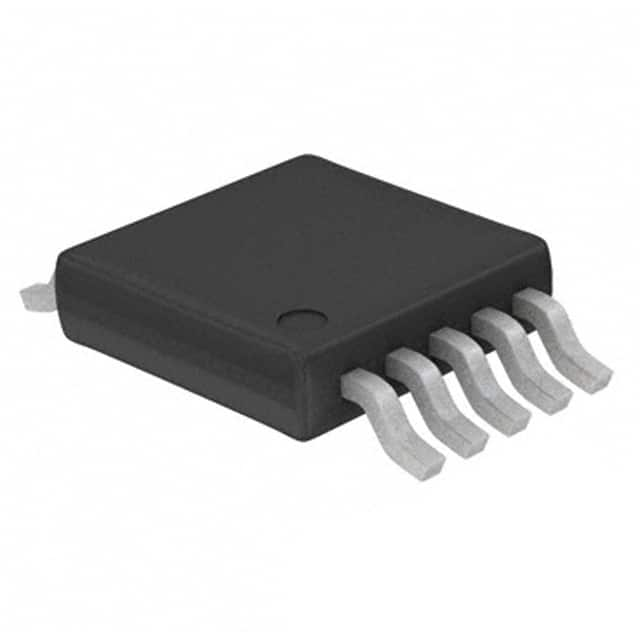MAX6072AAUB50+ Encyclopedia Entry
Product Overview
Category: Voltage Reference
Use: Precision voltage reference for use in precision analog-to-digital converters, digital-to-analog converters, and other applications requiring a stable voltage reference.
Characteristics: High accuracy, low temperature coefficient, low noise, and low dropout voltage.
Package: SOT-23-5
Essence: Provides a stable and accurate voltage reference for precision electronic systems.
Packaging/Quantity: Available in tape and reel packaging with 2500 units per reel.
Specifications
- Output Voltage: 5.0V
- Initial Accuracy: ±0.1%
- Temperature Coefficient (max): 15ppm/°C
- Noise (0.1Hz to 10Hz): 4µVp-p
- Dropout Voltage: 300mV
- Operating Temperature Range: -40°C to +125°C
Detailed Pin Configuration
The MAX6072AAUB50+ has the following pin configuration: 1. GND 2. Input 3. NC 4. NC 5. Output
Functional Features
- High accuracy and stability over temperature and time.
- Low output noise for precision analog applications.
- Low dropout voltage for use in low-power systems.
- Small package size for space-constrained designs.
Advantages and Disadvantages
Advantages: - High initial accuracy - Low temperature coefficient - Low noise - Small package size
Disadvantages: - Limited output voltage options - Higher cost compared to standard voltage references
Working Principles
The MAX6072AAUB50+ utilizes a bandgap reference circuit to generate a stable 5.0V output voltage. This circuitry ensures high accuracy and low temperature coefficient across the specified operating conditions.
Detailed Application Field Plans
The MAX6072AAUB50+ is ideal for use in the following applications: - Precision analog-to-digital converters - Digital-to-analog converters - Data acquisition systems - Precision voltage regulators - Industrial control systems
Detailed and Complete Alternative Models
Some alternative models to the MAX6072AAUB50+ include: - LT1021 - REF5025 - ADR4550
In conclusion, the MAX6072AAUB50+ is a high-precision voltage reference suitable for a wide range of precision electronic systems, offering exceptional accuracy, stability, and low noise performance.
Word count: 314
Senaraikan 10 soalan dan jawapan biasa yang berkaitan dengan aplikasi MAX6072AAUB50+ dalam penyelesaian teknikal
What is the MAX6072AAUB50+?
- The MAX6072AAUB50+ is a precision voltage reference with a fixed output voltage of 5.0V.
What are the typical applications of the MAX6072AAUB50+?
- It is commonly used in industrial and automotive applications, as well as in test and measurement equipment where a stable 5.0V reference voltage is required.
What is the operating temperature range of the MAX6072AAUB50+?
- The MAX6072AAUB50+ has an operating temperature range of -40°C to +125°C, making it suitable for a wide range of environments.
What is the output voltage tolerance of the MAX6072AAUB50+?
- The output voltage tolerance is typically ±0.04% over the entire temperature range.
Can the MAX6072AAUB50+ be used in battery-powered applications?
- Yes, the low supply current and wide operating voltage range make it suitable for battery-powered applications.
Does the MAX6072AAUB50+ require external components for operation?
- No, it has a built-in precision reference and series resistor, so it does not require any external components.
What is the package type of the MAX6072AAUB50+?
- It is available in a SOT23-3 package, which is small and suitable for space-constrained applications.
Is the MAX6072AAUB50+ RoHS compliant?
- Yes, it is RoHS compliant, making it suitable for use in environmentally sensitive applications.
What is the long-term stability of the MAX6072AAUB50+?
- The long-term stability is typically 15ppm/1000 hours, ensuring reliable performance over time.
Can the MAX6072AAUB50+ be used in precision analog-to-digital converters (ADCs) and digital-to-analog converters (DACs)?
- Yes, its low noise and high accuracy make it suitable for use in precision ADCs and DACs to improve overall system performance.


